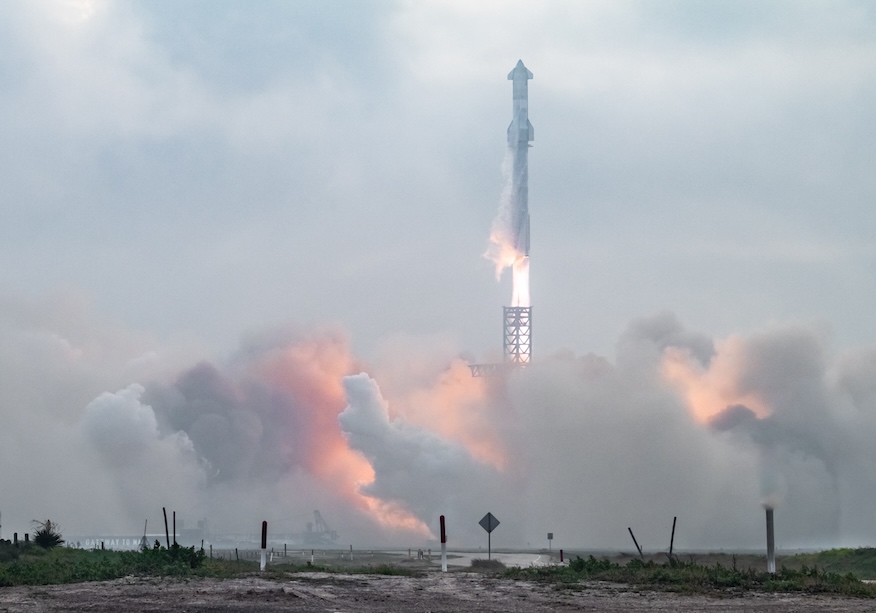
SpaceX’s Starship rocket took to the skies over Texas for a third time Thursday morning. The launch, approved on Wednesday afternoon by the Federal Aviation Administration, managed to navigate some tricky weather on its ascent.
Liftoff of the world’s tallest rocket currently flying took place at 8:25 a.m. CT (9:25 a.m. ET, 1325 UTC), towards the back end of a 110-minute window. The vehicle was stacked for launch late last week at SpaceX’s Starbase launch and manufacturing site in southern Texas near Brownsville.
The mission represents the shortest time between second and third flights for a commercial, orbital rocket. Both the Falcon 1 and the Falcon 9 spent more than a year between those two flights.
This mission flew a markedly different flight path compared to the previous two missions. SpaceX sent the Ship 28 upper stage nearly halfway around the world, with a splash down in the middle of the Indian Ocean, northeast of Madagascar, as the intended target.
SpaceX lost contact with Ship 28 nearly an hour after liftoff, but before its intended splashdown. The Super Heavy Booster 10 first stage also fell just short of reaching its full own full splashdown profile in the Gulf of Mexico.
In a similar fashion to the crewed launches at NASA’s Kennedy Space Center, a group of astronauts also performed a flyby of the rocket currently perched on the Orbital Launch Mount at Starbase ahead of the launch. This time, it was a pair of jets owned by businessman Jared Isaacman, which carried the crew of the forthcoming Polaris Dawn mission.
The third flight of the Polaris program is set to feature the first crewed launch of a Starship rocket.
Starship flyby pic.twitter.com/U39bWkfOxF
— Polaris (@PolarisProgram) March 13, 2024
Opening the doorway
Unlike the first two flights of Starship, the FAA issued a pair of primary documents connected to this mission: a “Tiered Environmental Assessment” and a “Finding of No Significant Impact/Record of Decision” (FONSI/ROD).
The FONSI concluded that pivoting to a splashdown in the Indian Ocean as opposed to off the coast of Hawaii in the Pacific Ocean (as was the aim for the first two Starship launches) “would not significantly impact the quality of the human environment within the meaning of NEPA (National Environmental Policy Act of 1969).”
Because of that, the FAA determined that they wouldn’t need to create a new Environmental Impact Statement. The FAA also agreed with SpaceX’s proposed action that would allow for “a total of ten nominal operations, including up to a maximum of five overpressure events from Starship intact impact and up to a total of five reentry debris or soft water landings in the Indian Ocean, within a year of issuance of a concurrence letter from that National Marine Fisheries Service.”
In response to a post on X, SpaceX founder Elon Musk said that they were aiming for “at least six more flights this year.”
Ramping up the cadence of Starship flights is going to be important not only for SpaceX’s ambitions with the program, but also for NASA.
Starship needs to launch several times successfully to prove its viability to work as the lander that will bring NASA’s astronauts to the surface of the Moon during the Artemis 3 mission, which is currently set for September 2026.
Before that happens though, they will need to perfect the ability to transfer propellant from one Starship rocket to another, which in and of itself will require 10 launches or more. SpaceX will also need to perform an uncrewed landing on the Moon, which is currently scheduled for sometime in 2026 as well.
During IFT-3, teams also performed a propellant transfer demonstration within the Ship 28 upper stage. SpaceX also intended to demonstrate a relight of one of the Ship Raptor engines as well as open and close the payload bay door during the coast phase of the mission, but they had to skip the engine demo.
In an effort to help long-term infrastructure, SpaceX is also exploring acquiring Space Launch Complex-37 (SLC-37) at Cape Canaveral Space Force Station as a possible launch site for Starship once it’s no longer supporting United Launch Alliance’s (ULA) Delta 4 Heavy rocket.
The Department of the Air Force (DAF) is overseeing this process and recently held in-person, public meetings along Florida’s Space Coast as well as a virtual meeting. All the comments gathered will be assessed against the proposal and a draft environmental impact statement (EIS) will be issued in December 2024 with a final EIS anticipated by September 2025.
>>> Read full article>>>
Copyright for syndicated content belongs to the linked Source : Spaceflight Now – https://spaceflightnow.com/2024/03/14/live-coverage-spacex-prepares-for-third-flight-test-of-its-starship-rocket-from-southern-texas/